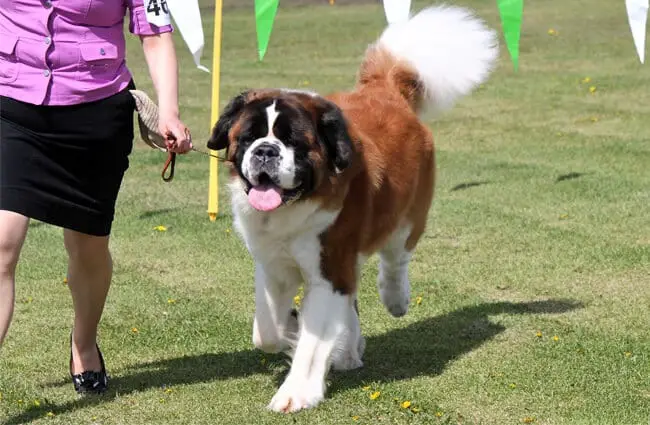A Gentle Giant: Unveiling the World of the Saint Bernard
The Saint Bernard is a breed synonymous with rescue and unwavering loyalty, steeped in history and characterized by its immense size and gentle disposition. Originating from the Swiss Alps, these dogs were initially bred by monks at the Great Saint Bernard Hospice to aid travelers lost or injured in the treacherous mountain passes. Today, while still embodying that rescue spirit, the Saint Bernard has become a beloved family companion, though one that demands considerable space and understanding.

History and Origins
The origins of the Saint Bernard can be traced back to large Molosser-type dogs that arrived in Switzerland during Roman times. These sturdy working dogs mixed with local mountain breeds, forming the foundation of the Saint Bernard we recognize today. The monks at the Saint Bernard Hospice carefully selected for intelligence, courage, a keen sense of smell, and a naturally gentle temperament. Beyond rescuing, the dogs provided warmth to travelers during blizzards and alerted the monks to those in need. The legendary Barry, a Saint Bernard who is credited with saving more than forty lives, exemplifies the breed’s historical role.
Physical Characteristics
Saint Bernards are undeniably large. Males typically stand 28 to 30 inches tall at the shoulder and weigh between 140 and 180 pounds. Females are slightly smaller, measuring 26 to 28 inches and weighing 120 to 140 pounds. There are two recognized coat types: short-haired and long-haired. Both have a dense double coat that provides excellent insulation against cold weather. The classic color pattern is white with red or mahogany markings, though variations exist. A distinctive feature is the loose skin around their head and neck, which does not indicate a health problem but contributes to their unique appearance. Their powerful build, broad head, and expressive eyes give them a noble and dignified look.

Temperament and Behavior
Despite their size, Saint Bernards are known for their remarkably gentle and patient temperament. They are exceptionally good with children, earning them the nickname “nanny dogs.” They are generally friendly toward strangers, though early socialization remains crucial. While not overly energetic, they do require regular exercise to maintain a healthy weight and prevent boredom. They are intelligent dogs but can be somewhat stubborn, requiring consistent and positive reinforcement training methods. Due to their history as working dogs, they have a strong sense of duty and enjoy having a job to do, even if it’s simply carrying a backpack on a walk. They are not typically vocal dogs, but may bark to alert their owners to something unusual.
Caring for a Saint Bernard
Owning a Saint Bernard is a significant commitment. Here’s a breakdown of their essential needs:
- Space: These dogs need ample space to move around comfortably. A large house with a fenced yard is essential. Apartment living is not recommended.
- Exercise: While not requiring intense exercise, Saint Bernards need at least an hour of moderate activity daily. Walks, hikes, and playtime are all good options.
- Grooming: Their thick double coat requires regular brushing, especially during shedding season. Occasional bathing is also necessary.
- Diet: Saint Bernards are prone to bloat (gastric torsion), a life‑threatening condition. Feeding several smaller meals throughout the day instead of one large meal, and avoiding vigorous exercise immediately before or after eating, can reduce the risk. A high‑quality, large‑breed puppy food is essential for proper growth and development.
- Training: Early socialization and obedience training are vital. Positive reinforcement methods work best. Consistency is key.

Health Considerations
Like all breeds, Saint Bernards are predisposed to certain health issues. Common concerns include:
- Hip and Elbow Dysplasia: Genetic conditions that affect the joints. Responsible breeders screen for these conditions.
- Osteosarcoma: A type of bone cancer more common in large breeds.
- Bloat (Gastric Torsion): A life‑threatening condition that requires immediate veterinary attention.
- Cardiomyopathy: A disease of the heart muscle.
- Entropion/Ectropion: Conditions affecting the eyelids.
- Hot Spots: Skin infections caused by excessive licking and scratching.
Regular veterinary checkups and preventative care are essential for maintaining a Saint Bernard’s health and well‑being.

Is a Saint Bernard Right for You?
Saint Bernards are wonderful companions for the right owner. They thrive in families who can provide plenty of space, attention, and consistent training. They are not a good fit for first‑time dog owners or those who lead a very active lifestyle. Potential owners should be prepared for a significant financial commitment, as these dogs require a substantial amount of food, veterinary care, and grooming. However, for those who can meet their needs, a Saint Bernard will reward them with unwavering loyalty, gentle companionship, and a whole lot of love.

Beyond the Basics: Specialized Considerations
For those deeply invested in the breed, several nuanced aspects deserve attention. The Saint Bernard breed standard emphasizes structural soundness; deviations can predispose the dog to joint problems later in life. Understanding these conformational faults is vital for breeders and serious enthusiasts. Furthermore, the breed’s history as a working dog means they possess a strong drive to carry things. Providing them with appropriate tasks, like pulling a small wagon or carrying a backpack, can give mental stimulation and prevent boredom. Finally, Saint Bernards are known to drool, especially after drinking or eating. While some owners find this endearing, others may need to be prepared for regular cleanup.

In conclusion, the Saint Bernard is a truly remarkable breed—a gentle giant with a rich history and a loving heart. While they require a significant commitment, the rewards of owning a Saint Bernard are immeasurable.






![Red Angus Closeup of a beautiful Red Angus cowPhoto by: U.S. Department of Agriculture [pubic domain]https://creativecommons.org/licenses/by/2.0/](https://animals.net/wp-content/uploads/2020/03/Red-Angus-4-100x75.jpg)

